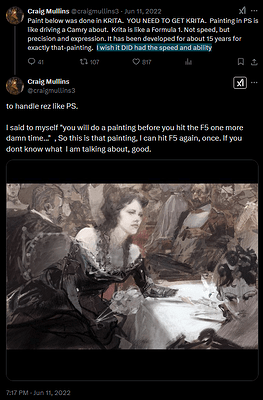 Hello @LuxoAnticuxo and welcome to the forum!
Hello @LuxoAnticuxo and welcome to the forum!
To answer your question, at least in part:
I can’t tell you exactly when GPU acceleration for the Brush Engines will come, but it won’t be before porting Krita to Qt6, otherwise you’d probably have to do the work twice (at least partially).
As for your claim that you have already tried everything to improve Krita’s responsiveness with large brushes on large canvases, I doubt it.
There is one thing that helps Krita tremendously to use large canvases with large brushes, and that is powerful PCs. And I’m not talking about the gaming PCs of many users with super GPUs that cost € 2k or more, which are currently a bad investment if you want to do professional graphics editing, not just with Krita. In the case of Krita, I’m talking about PCs with CPUs that have the highest possible single-thread performance, whereby the multi-thread performance and number of processor cores should also be high, especially for animation, and which should be equipped with as much RAM as possible. AMD Threadripper and Intel XEON processors (and then the few top-of-the-line Core i9 CPUs) would be the best choice here, and depending on the motherboard, you could also add entire batteries of professional graphics cards (three, four, five, six) if you also want to use 3D software such as Blender or similar, or if Krita should get GPU acceleration at some point (then, this will kick Krita into the big leagues  ). The disadvantage is that it costs a lot of money!
). The disadvantage is that it costs a lot of money!
But you can also fall back on used workstations from the professional sector, what is discarded by engineering offices or graphics studios is often still usable for a very long time for the hobby sector, I use such a workstation.
With a standard operating system, such as Windows 10 or 11 even in the professional version, often only 64 GB of RAM can be used/addressed properly, so if, like me, you want to use more and benefit from it, you have to fall back on the workstation versions or Windows Server, but then you can give Krita what it seems to love and what really drives Krita, RAM!
With Linux, it’s a question of which distribution you use. And speaking of Linux, Krita runs significantly better on the same hardware!
Even my now 15-year-old workstation can handle canvases of 10k at 10k and brushes of 3k pixels quite well using Windows, what current workstations can do here I hope to experience on my next one.
Another point in your message makes me smile bitterly. No matter what Craig Mullins or, for all I care, Elon Musk, Bill Gates or Donald Duck say, it’s in the wrong direction! What Krita really lacks to improve the performance on consumer PCs from the supermarket or on gaming PCs from specially assembled (usually better) consumer hardware, which is lamented by more than a few, is money. Money to enable Krita to employ a sufficient number of developers.
Because only then can you compare Krita to programs made by companies that are usually multi-billion dollar companies, like the OPs example, that can spend more on optimizing the performance of a new version than Krita has for developing a new version, and only if users are willing to support Krita’s development with more donations, and Krita can fully fund maybe 15 or 20 developers instead of 5 (which is still significantly less than its commercial competitors), will Krita be able to achieve the performance that so many people want faster.
But for this to happen, users would also have to dig deep into their pockets to equip Krita with this, instead of always just looking at “free, free” and not recognizing the connection between money and performance. And so Krita naturally needs more time to get faster, so what?
Michelist
